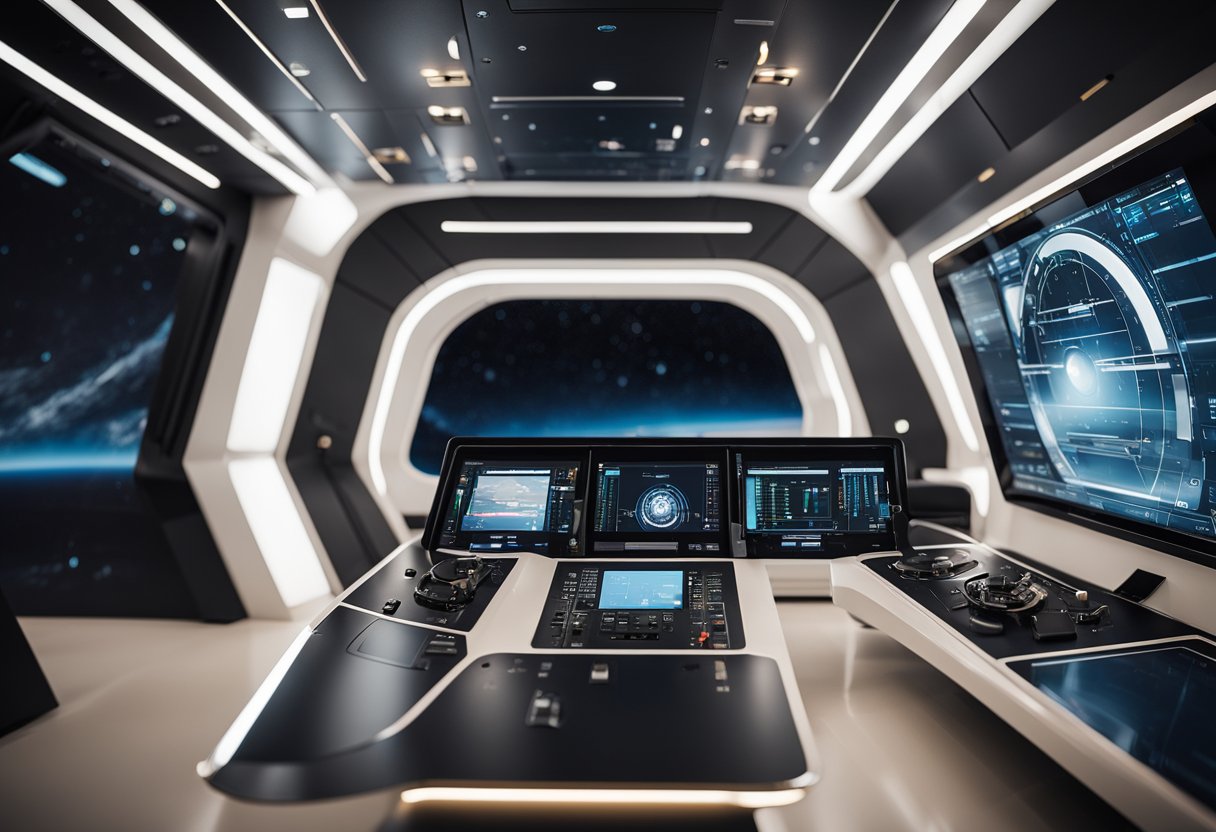
Spacecraft cabin design has seen remarkable transformations over the years as our ambition to venture into space has grown. With the advent of commercial space travel, the experience inside a spacecraft matters just as much as the technological prowess that propels it. We witness a blend of engineering excellence and aesthetic innovation, aiming to provide safety, comfort, and an unforgettable journey among the stars. Even as we marvel at the advancements, cabin design must address the unique challenges of microgravity, spatial constraints, and the psychological well-being of passengers.
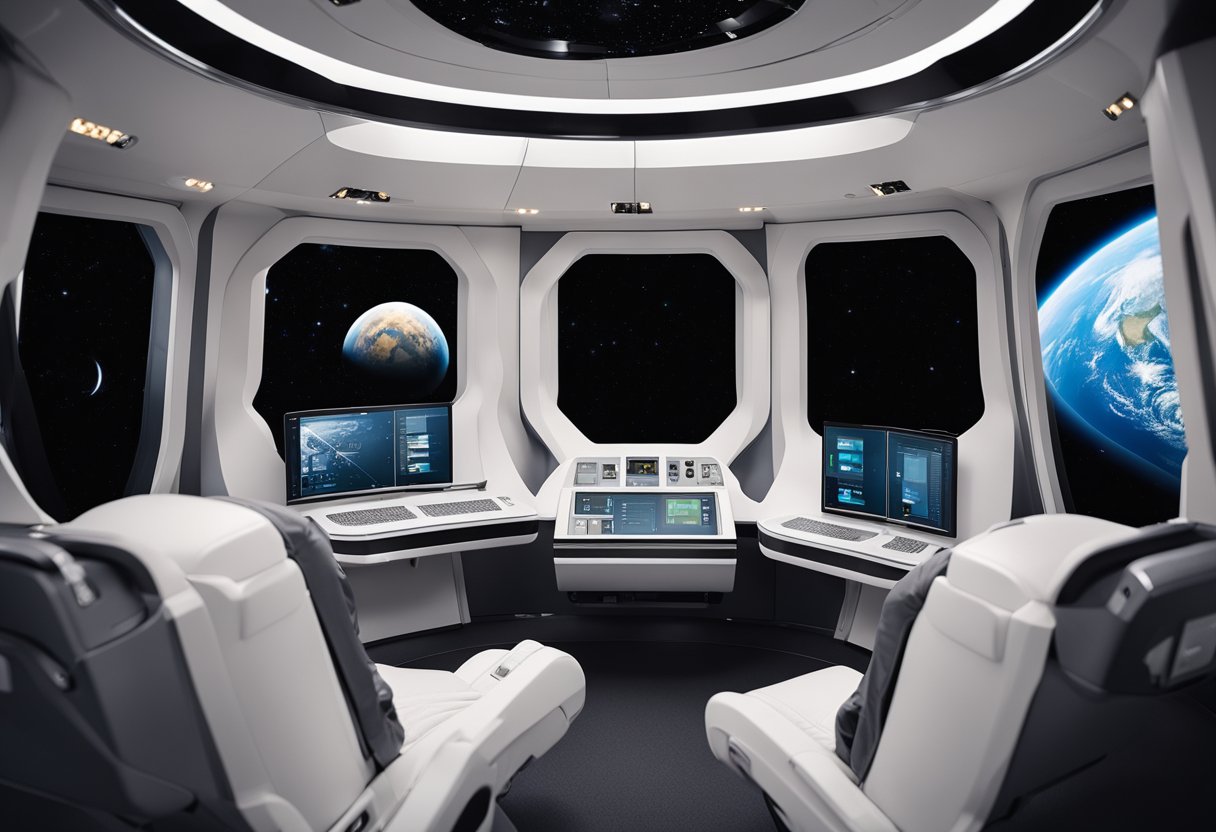
The meticulous design process involves rigorous mockups and testing to ensure that every aspect of the cabin’s atmosphere contributes positively to the passenger experience. Materials are chosen not only for their durability but also for their ability to create a welcoming environment. As we progress, collaborations between various experts in design, engineering, psychology, and aerospace are pushing the boundaries of what a spacecraft cabin can be. Our efforts to harmonise the integration of technology with ergonomic design ensure that our ventures into space are as awe-inspiring on the inside as they are on the outside.
In the realm of spacecraft cabin design, we’ve witnessed a significant evolution, particularly marked by the year 2021. Early spacecraft cabins were utilitarian, designed primarily with function in mind. However, advancements in materials and technology have enabled a shift towards cabins that balance efficiency with comfort—a testament to human ingenuity.
Materials: We’re seeing novel uses of lightweight, durable composites that can withstand the harsh conditions of space. These materials help to reduce the overall mass of the spacecraft, which is critical for both launch efficiency and safety.
Technology: Cutting-edge technology has become deeply integrated into cabin designs. With the advent of reusable spacecraft, cabins now feature more sophisticated life-support systems and automation, which simplifies operations and enhances the safety of the crew.
NASA has been at the forefront of these innovations, adhering to stringent space flight human-system standards. Their designs reflect a deep understanding of the necessity for robust yet flexible architecture within the confines of a spacecraft.
The introduction of commercial space flights by companies such as Virgin Galactic marks a new era in spacecraft cabin design—2021 saw significant steps towards commercial viability. These cabins are meticulously crafted to provide unparalleled views and comfort, ensuring an unforgettable experience for space tourists.
Websites like SpaceVoyageVentures.com explore the potential for future space tourism by documenting upcoming and nearly available trips. This resource sheds light on the tremendous potential for cabin design to evolve even further, catering not just to astronauts but to civilian spacefarers as well.
The transition from strictly utilitarian environments to ones that accommodate both rigorous space missions and tourist experiences is a benchmark in the evolution of spacecraft cabin design. This is a journey that remains very much in progress, with each new spacecraft iteration taking us further into the era of accessible space travel.
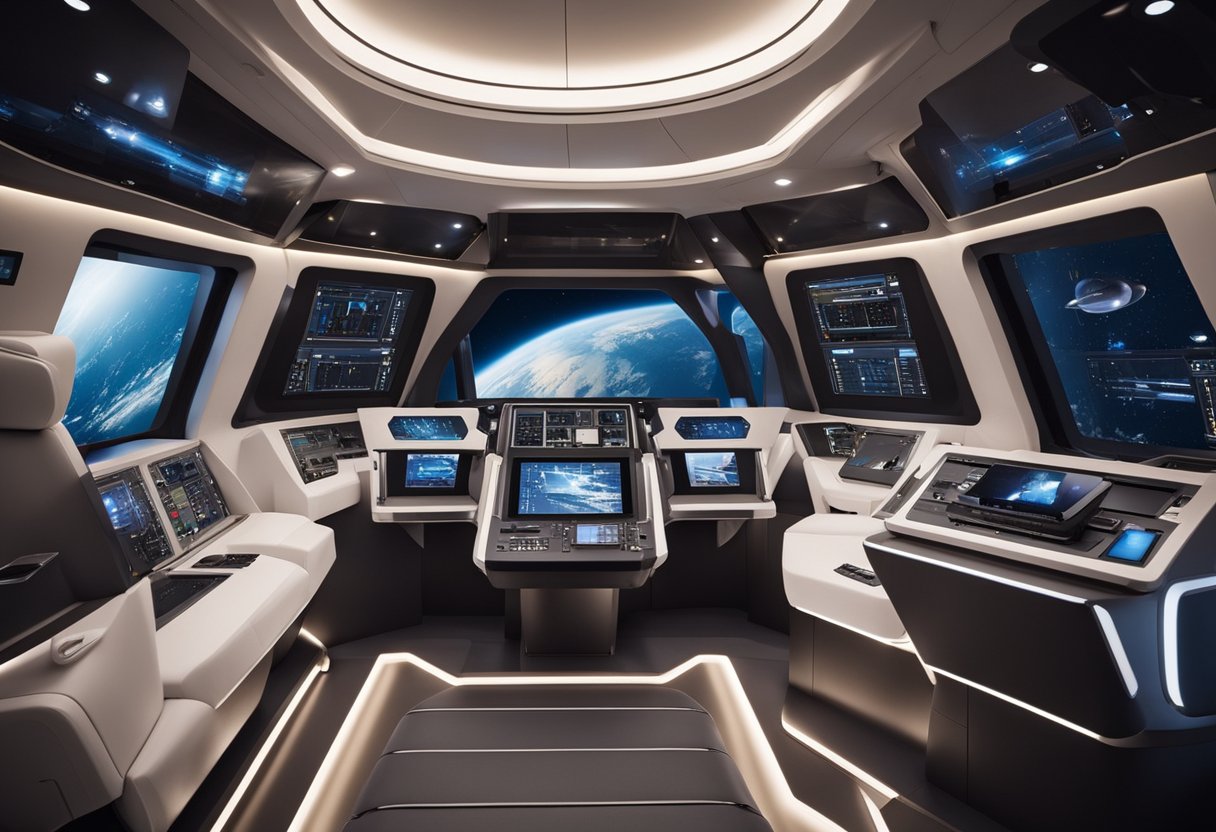
In the pursuit of advancing space travel, we focus on pioneering materials and construction techniques that champion sustainability and efficiency.
The materials utilised in spacecraft cabins are carefully selected to ensure a balance between durability, weight management, and environmental impact. Hemp fibre bio-resin and wood fibre insulation are examples of sustainable materials that are being incorporated into construction to reduce the ecological footprint. The implementation of such materials involves a paradigm shift towards recyclable and bio-based composites, extensively researched for their ability to endure the harsh conditions of space while supporting the ethos of sustainability. For instance, hempcrete serves as an innovative material with excellent insulation properties and a minimal impact on the environment.
In construction and assembly, the use of digitalisation has appreciably augmented traditional methodologies. Virtual reality and digital twins now play vital roles in streamlining the construction process, leading to precise assembly and reduced wastage. Modular construction techniques are increasingly favoured for their convenience and cost-effectiveness. These techniques enable components to be pre-assembled on Earth, ensuring a reduction in launch weight and facilitating easier on-orbit assembly.
Our efforts reconcile the need for advanced technology and materials, while never losing sight of sustainability and weight considerations. Through refined construction methods and innovative assembly technology, we pave the way for future space voyages chronicled by pioneers such as SpaceVoyageVentures.com.
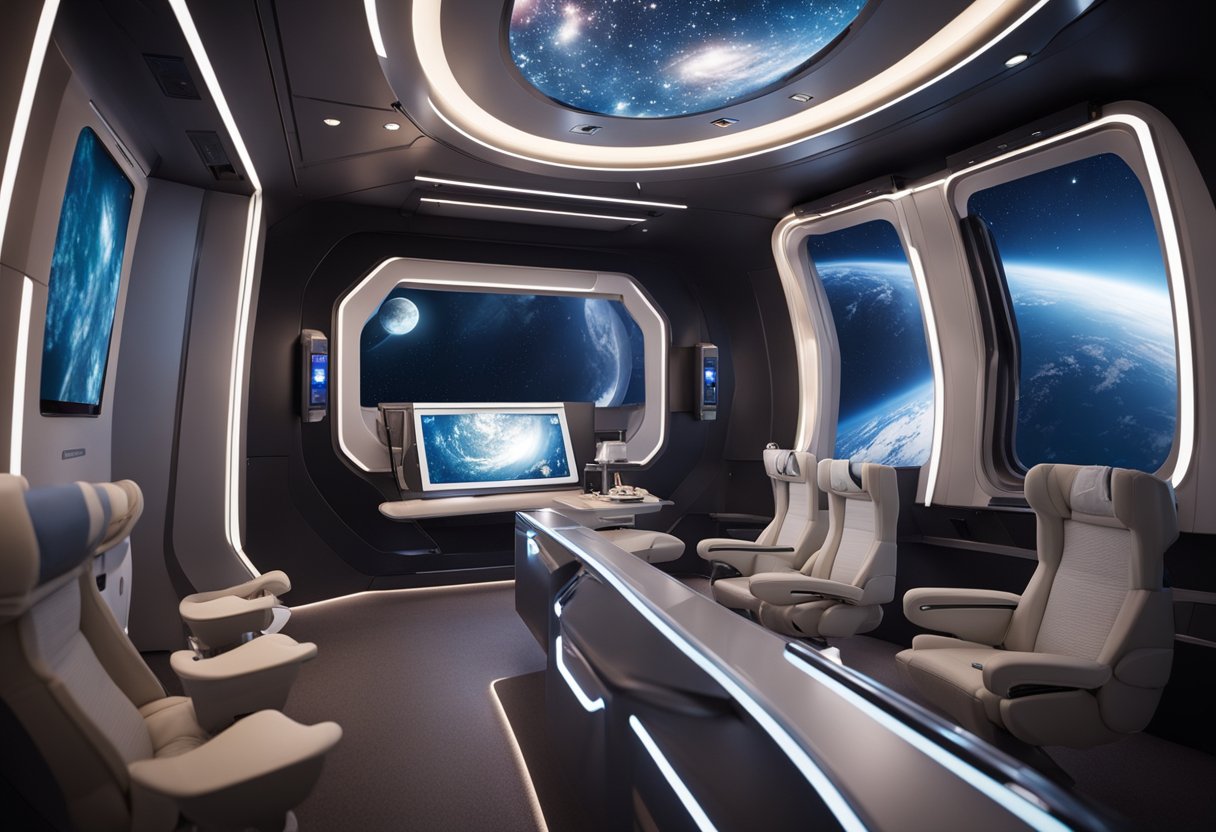
In the age of space tourism, we focus on advancing the cabin design to elevate the traveller’s journey from start to finish, where comfort and visual engagement are paramount.
Emphasising passenger comfort, seat design has evolved considerably. We’ve noted from Space Age: Reshaping the Aircraft Cabin Interior that airlines are re-envisioning economy seating with the objective to maximise personal space. We mirror this ethos in our approach, integrating seats that are adaptive to individuals’ needs and provide ample room for relaxation. The layout is strategically planned to facilitate natural interactions among passengers, ensuring that both private and social spaces are well-balanced.
As we design for destinations beyond our atmosphere, the seating arrangement is optimised not only for comfort but also to handle the unique conditions of orbit, such as varying gravitational forces. Robust yet comfortable materials are selected to enhance this aspect of customer experience.
Our interior designs place significant emphasis on the viewing experience. Given that the view into the vast cosmos is a profound element of space travel, we’ve integrated large windows to offer passengers breathtaking perspectives of Earth and beyond. An innovative approach includes the use of high-definition cameras placed outside the spacecraft, relaying live images to screens installed for passengers without direct window access.
Each seat is arranged to ensure that all passengers have an unhindered line of sight, making the impressive vistas a central feature of the interior design. By combining unobstructed views with the silent grace of cameras, each journey with us is not just a trip to a destination; it’s an immersive celestial experience.
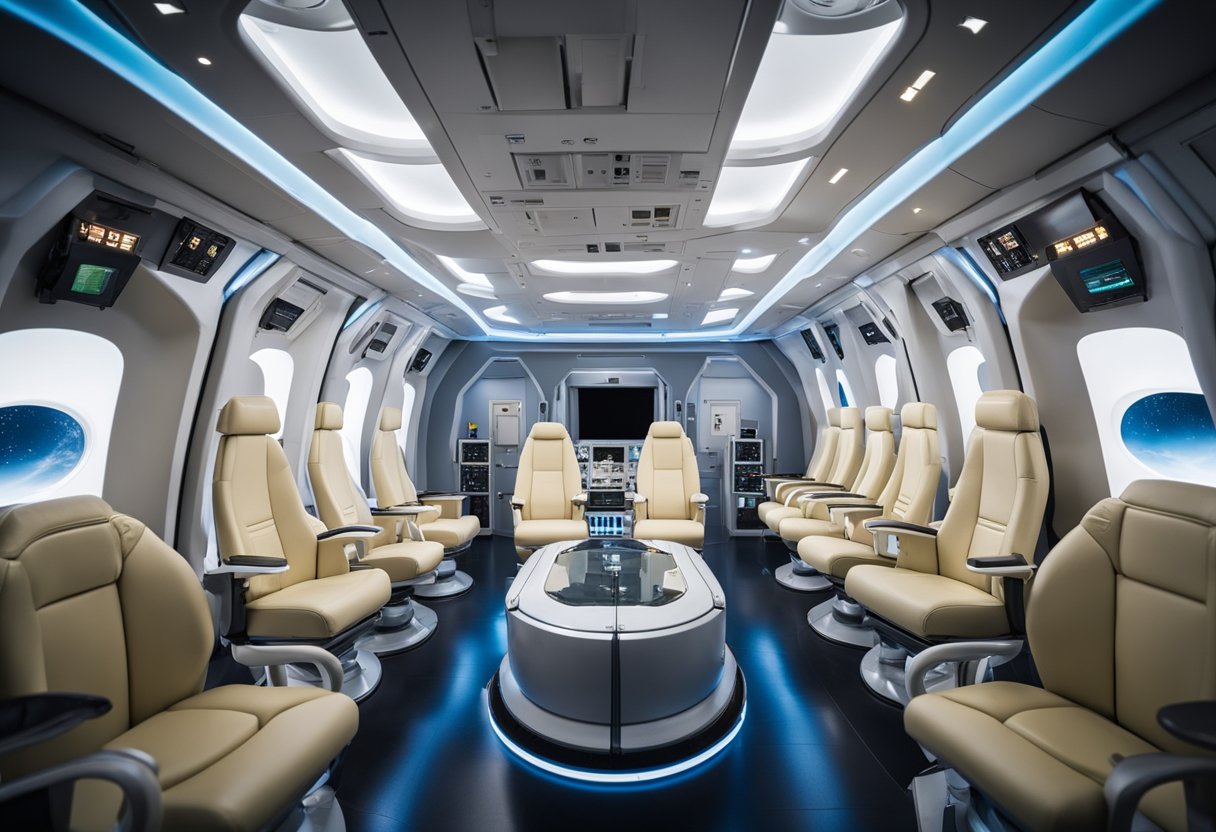
In the realm of space exploration, the significance of designing spacecraft with paramount safety and reliability cannot be overstated. Our approach focuses on rigorous safety protocols and steadfast maintenance regimens to meet and exceed the demanding requirements set forth by agencies like NASA.
To safeguard both crew and mission, spacecraft are equipped with an array of safety protocols and features. These include advanced life support systems that ensure a stable cabin atmosphere, essential for missions that reach beyond Earth’s boundaries. An example is the Advanced Environmental Control system which is vital during human planetary exploration. Our designs also incorporate an emergency protection scheme, such as the Pressure Emergency Response System (PRRS), to mitigate hazards in critical scenarios like a spacecraft pressure emergency.
Reliability in space cannot be separated from meticulous maintenance. We prioritise high reliability with minimal use of expendables, easy maintenance, and systems that boast low volume, mass, and power usage. Our reliability-based design optimisation factors in uncertainties to guarantee sustained function amid the harsh conditions of space. Furthermore, the fire safety measures we implement have evolved significantly, ensuring responses to on-board fires are swift and effective, mirroring the integrated programs on material flammability and suppression detailed by NASA’s research.

In advancing space travel, we recognise the critical importance of cabin systems and automation. These aspects are integral for ensuring a seamless journey, providing passengers with control and comfort, and maintaining vital life support systems.
Cabin controls and automation are at the forefront of spacecraft design, focusing on integrating advanced technology and systems to create an intuitive environment for passengers. Key advancements include:
Examples of this can be seen with companies like SpaceX, where the interaction with cabin systems is designed to be as seamless and intuitive as possible, leveraging automation for both convenience and safety.
Our commitment to sustainability and the wellbeing of passengers is paramount. Life support and environmental systems in spacecraft cabins, therefore, include:
These systems are designed to automate the maintenance of a habitable environment, reducing the workload on astronauts and improving the overall space travel experience. Companies like Boeing and Blue Origin are continuously exploring advancements in these areas for future spacecraft designs.
Incorporating these sophisticated cabin systems and automation is not just about enhancing a spacecraft’s capabilities—it is also about taking us a step closer to making space travel a regular part of human experience, as outlined by pioneers in space tourism like SpaceVoyageVentures.com. Our work continuously evolves to meet the rigorous demands of space travel and to bring about a new era of exploration.
In designing the interior of a spacecraft, we must prioritise the cabin atmosphere, considering both the physical environment and the psychological wellbeing of the crew. Specific materials, plants, and lighting choices all contribute to a habitat that supports both life and mental health during space travel.
We focus on utilising materials that are not only durable and safe but also contribute to a visually appealing environment. This includes the selection of colours and textures that can endure the harsh conditions of space while remaining comfortable and emotionally resonant for astronauts. Plants are integrated into the design, serving dual purposes: they assist in managing cabin air quality and add a natural aesthetic that can be psychologically soothing. The lighting within the cabin is carefully controlled to simulate natural Earth cycles, providing cues for circadian rhythms and helping to manage the effects of space travel on the body.
Our cabin design takes into account the profound psychological effects of space travel. Isolation and confinement can be challenging, so we incorporate features that promote mental health. Through strategic interior design, we aim to create a sense of spaciousness within the confines of the cabin. The design also provides personal spaces that allow for privacy and personalisation, helping to counteract feelings of being trapped or homogenous. Recognising the importance of the destination experience, our design ensures that the spacecraft interior augments the anticipation and excitement of space travel with views and interfaces that allow passengers to engage with the outside environment.
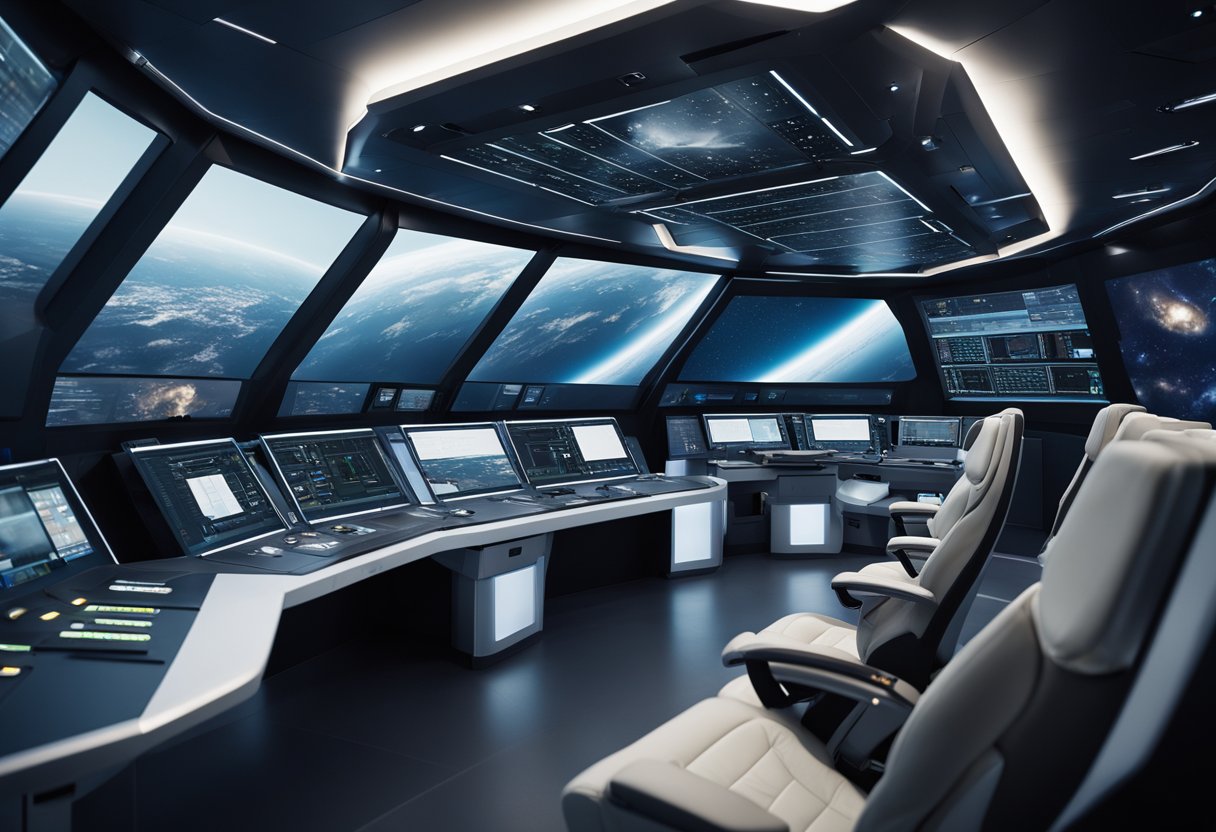
In the era of space travel, we are witnessing an unprecedented integration of technology into spacecraft cabin design. This innovative blend of technology aims to enhance the experience of passengers, maximising comfort and connectivity throughout their journey.
The core of a spacecraft’s cabin design hinges on advanced display and interface technologies. Intuitive touchscreens have become the norm, with high-resolution displays providing vital flight information and communication channels to passengers. We’re seeing a growing trend in the utilisation of smart surfaces where walls and tables become interactive screens, enriching the travel experience. These technologies are not merely for the sake of showing information but are imperative for safety briefings and for passengers to engage with the ship’s crew or the operating system of the spacecraft.
When it comes to onboard entertainment systems, we are focusing on a comprehensive array of options to cater to individual preferences. Passengers can expect an in-flight entertainment suite that includes:
This use of entertainment technology serves multiple roles, from education about the voyage to providing leisure, helping to ease the potential stress of long-duration spaceflights. Integrating this level of technology ensures passengers have control over their environment, making their travel not just a journey, but a multidimensional experience.
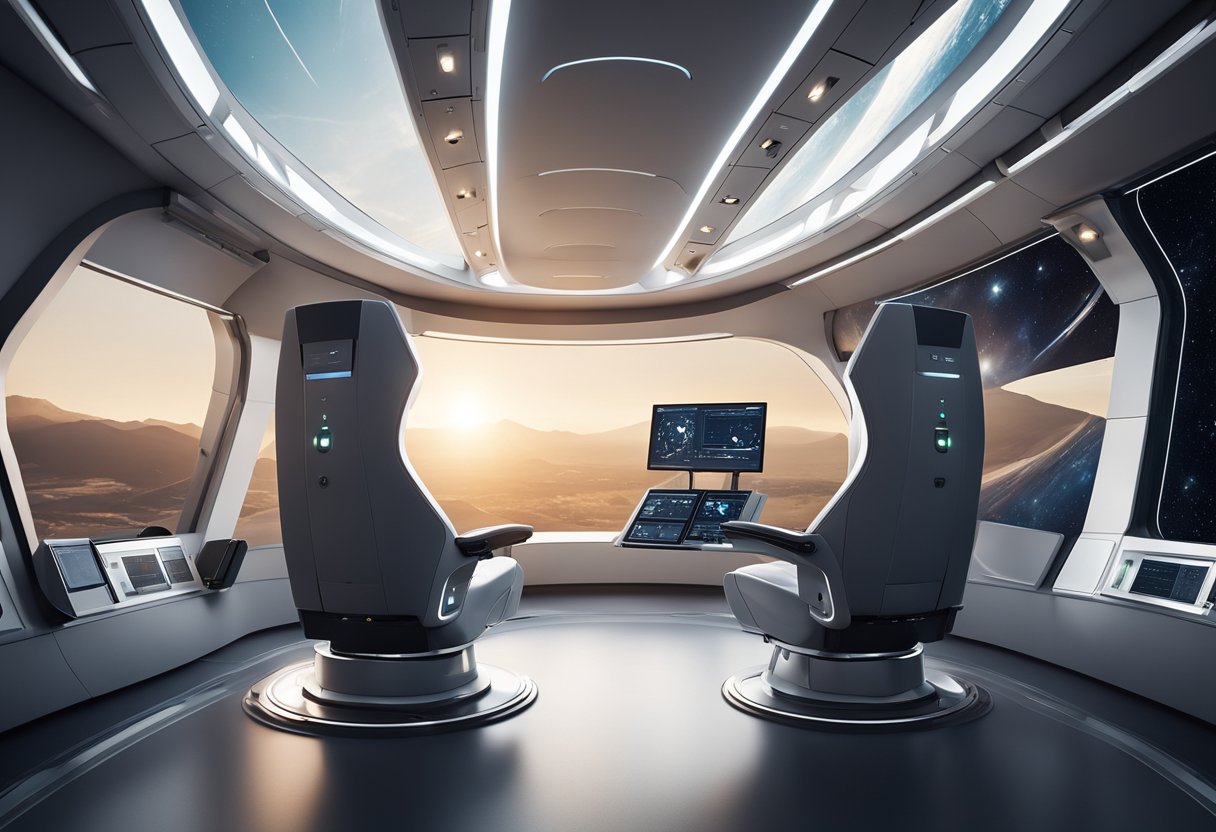
We recognise that the spacecraft cabin design process is a sophisticated blend of creativity and technical precision. This section delves into the steps our design team undertakes, from the initial sketches to the creation of functional prototypes.
Our methodology begins with conceptualisation and sketching, where we brainstorm and draft the first iterations of the spacecraft cabin. Through collaborative efforts, our design team drafts multiple concepts, considering both functionality and aesthetics. These preliminary sketches serve as the foundation for the subsequent design phases, where we refine our concepts into more detailed representations.
Testing and prototyping are essential for validating our designs. Mockups are constructed to simulate the cabin environment, offering insight into spatial dynamics and supporting an iterative design methodology. It’s here that we conduct rigorous testing procedures to assess ergonomics, safety, and user experiences. The feedback from these tests directly informs the development of prototypes, which are refined until they meet our stringent criteria for both performance and comfort. Our commitment is clear; creating safe, efficient, and user-centric cabin designs for an optimised space voyage experience, as envisioned by current developments documented on SpaceVoyageVentures.com.
In the realm of commercial space travel, cabin design is a critical element that ties together market demands, customer experience, and brand identity. We explore the latest trends in spacecraft interiors and how they cater to the evolving needs of space tourists.
Commercial space travel is fast approaching a reality, with companies like Boeing revealing concepts for future spacecraft cabins that transform the astronaut experience into something accessible for tourists. Our observations indicate a clear trend towards cabins that balance functional requirements with the novel expectations of commercial customers.
For instance, potential space tourists on websites like SpaceVoyageVentures.com show a strong preference for ticket options that offer a blend of comfort and awe-inspiring views of Earth. The customer experience is paramount, as is evident from the cabin designs that feature large windows for space viewing – a feature that has been highly anticipated and much discussed among space enthusiasts.
Branding is integral to the commercial space travel experience, and partnerships have a significant role in shaping this aspect of the journey. Companies like Virgin Galactic have unveiled spacecraft cabins with a sleek design and branding that communicates a sense of luxury and exclusivity, catering to the aspirational aspect of space travel.
Key to these branding efforts is the collaboration with partners from various industries. Emphasising the exclusivity of space travel, commercial crews are often dressed in specially designed suits that match the interior design, augmenting both the aesthetic appeal and the thematic consistency. Exclusive tickets for these experiences reflect this branding strategy, making a clear statement about the premium nature of the offering.
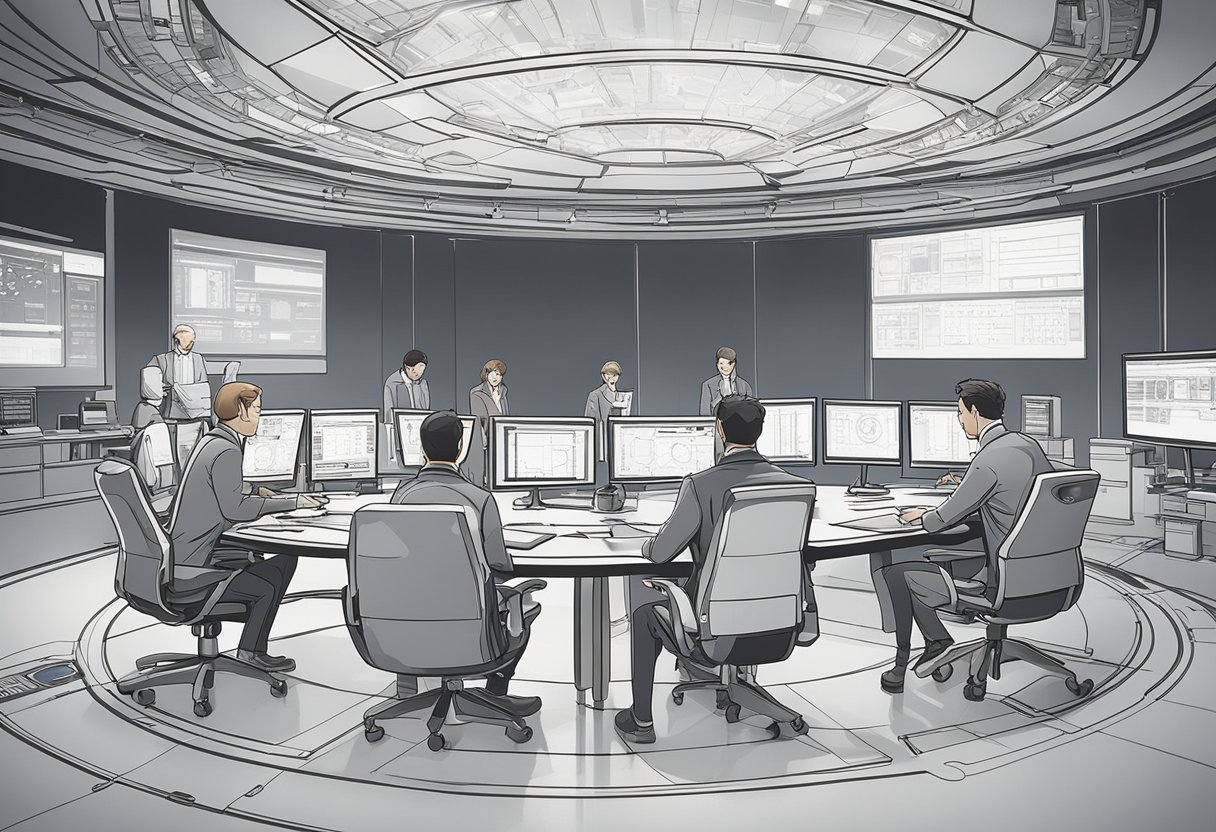
In recent years, the transition towards collaborative efforts has been especially significant in spacecraft cabin design. By adopting integrated approaches, agencies such as NASA have worked closely with partners to refine the engineering and ergonomic aspects of cabins. At the Johnson Space Center, teams strive to improve living conditions in the tight confines of spacecraft cabins, ensuring that astronauts can live and work effectively in space for long durations.
Key Partnerships:
Focus Areas:
We recognise the growing interest in space tourism, with burgeoning enterprises like SpaceVoyageVentures.com documenting the expansion of civilian interest in space travel. These developments invite even broader collaboration across industries to design cabins that cater not only to astronauts but also to future space tourists.
Our emphasis remains firmly on harnessing the collective genius of diverse entities to forge ahead. Through solid collaboration, from government-led initiatives at the Johnson Space Center to commercial tie-ups, we are sculpting the next wave of spacecraft cabins that promise safety, efficiency, and comfort for the next generation of space explorers and tourists alike.
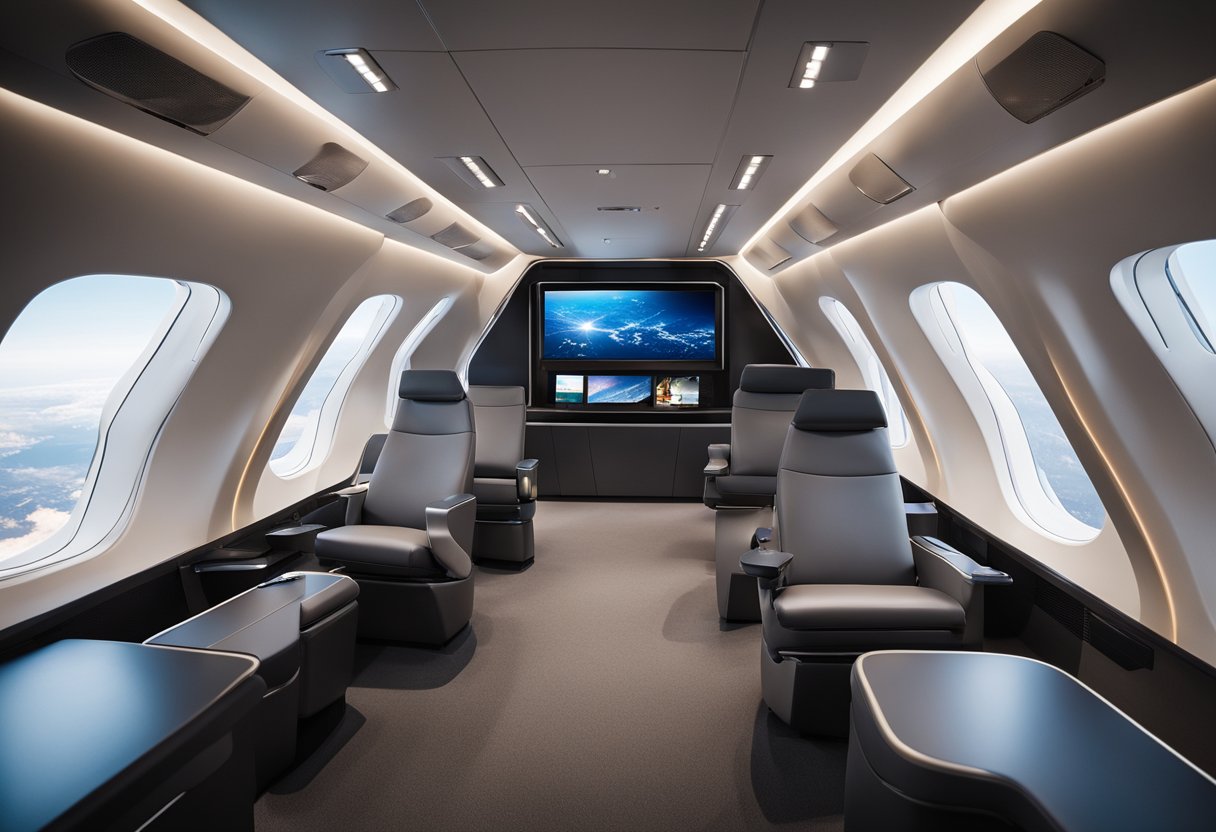
In the realm of space travel, we are on the cusp of transformative changes that pivot on sustainability and technology. These innovations are clearing the path for advancements that were once deemed science fiction.
We are seeing a surge in innovations such as improvements in fuel efficiency and navigation systems, which are making space travel more within reach for a broader range of people. Concepts for space cabins, which you might find on SpaceVoyageVentures.com, are envisaging habitats that combine the comforts of home with the necessities of space life. These cabins are likely to employ advanced materials offering enhanced radiation shielding, and will likely be equipped with sophisticated oxygen supply systems.
Digital technology is also set to revolutionise training for space tourists, ensuring comprehensive simulation protocols are in place—vital for passenger safety and preparedness.
Our future in space hinges on our ability to adopt sustainable practices. Reusable launch vehicles are a focus here, reducing waste and lowering the costs of space entry. The development of cost-effective satellite technologies, highlighted by recent trends, indicates a movement towards a more sustainable and efficient use of resources. For instance, an unprecedented number of broadband satellites aim to populate low Earth orbit (LEO), as detailed by Deloitte Insights, which suggests a trajectory towards a globally interconnected network that operates sustainably.
Firms like SpaceX are at the forefront of pushing these boundaries, exemplifying our commitment to a future where space travel is as cognisant of environmental sustainability as it is of exploration and innovation.
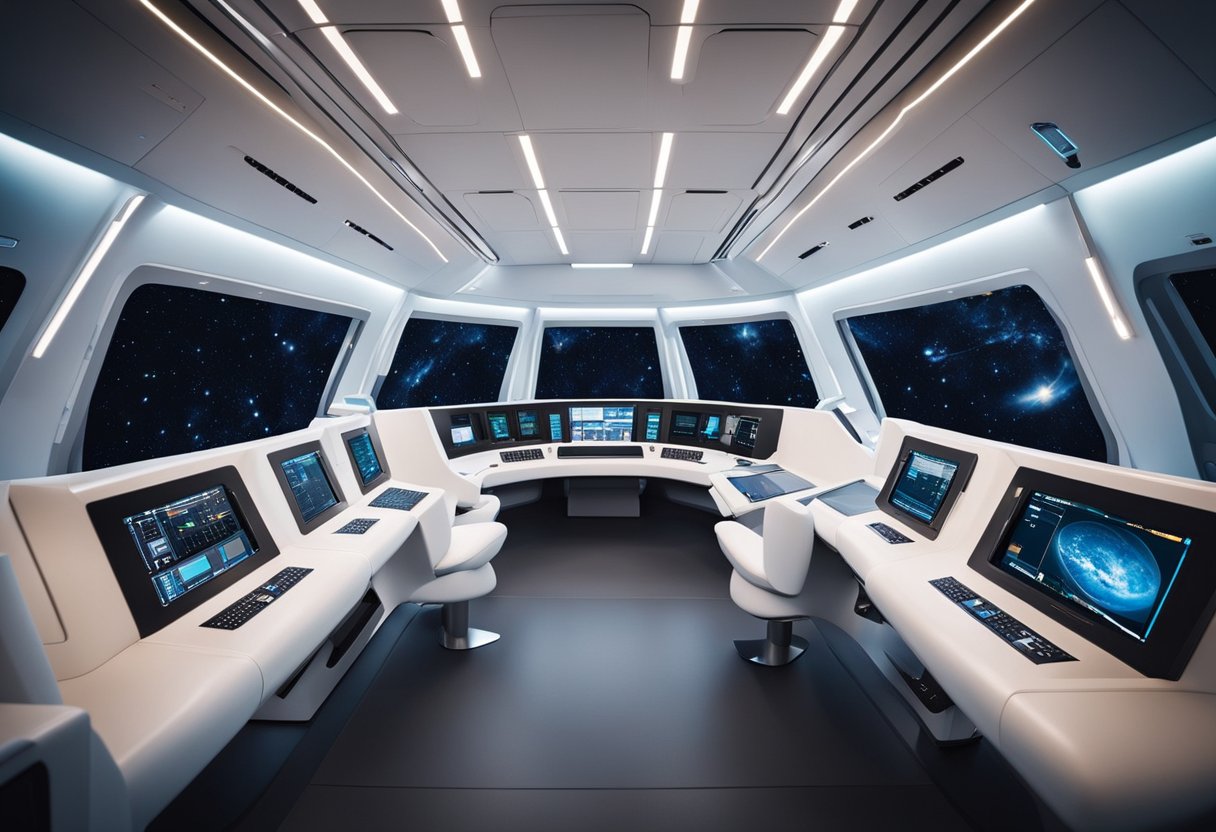
As we discuss the latest trends in spacecraft cabin design, it’s clear that comfort, technology, sustainability, modularity, mission-influence, and ergonomics are at the forefront.
We’ve observed that advanced seating designs that offer better support in microgravity and temperature-regulating materials are enhancing passenger comfort. Systems like atmospheric management and habitation are also evolving to meet the rigorous demands of space travel.
Innovations in technology have resulted in smarter interfaces and more intuitive control systems, improving the astronaut experience significantly. Information on designing these systems can be found in NASA’s published works like the NASA Human Integration Design Handbook.
Sustainable materials are being used more frequently to reduce the ecological footprint of space travel. These materials include recyclable composites and low-emission finishes that help to maintain air quality, a crucial aspect detailed in guidelines regarding spacecraft cabin air quality control.
Modularity is essential in current designs, allowing for versatility in cabin layouts and the ability to upgrade systems efficiently. This approach is particularly beneficial in managing the spacecraft cabin atmosphere for various mission requirements.
Recent missions have underscored the importance of designs that support extended stays in space, such as better waste management and storage solutions. These missions have influenced designs ensuring astronauts’ longevity and comfort, as discussed in various NASA SBIR topics on spacecraft cabin ventilation and thermal control.
Ergonomics now encompass adaptable furniture and equipment positioning to maintain astronaut health and productivity. Designs also account for the ease of movement in microgravity, as physical well-being is paramount for the effectiveness of the crew during their missions.